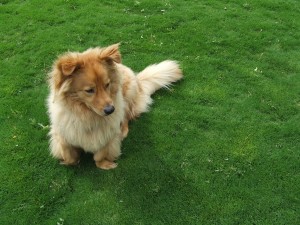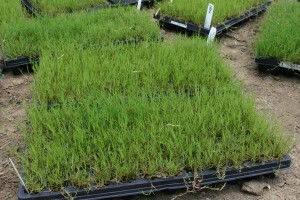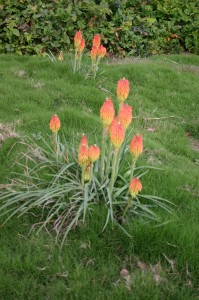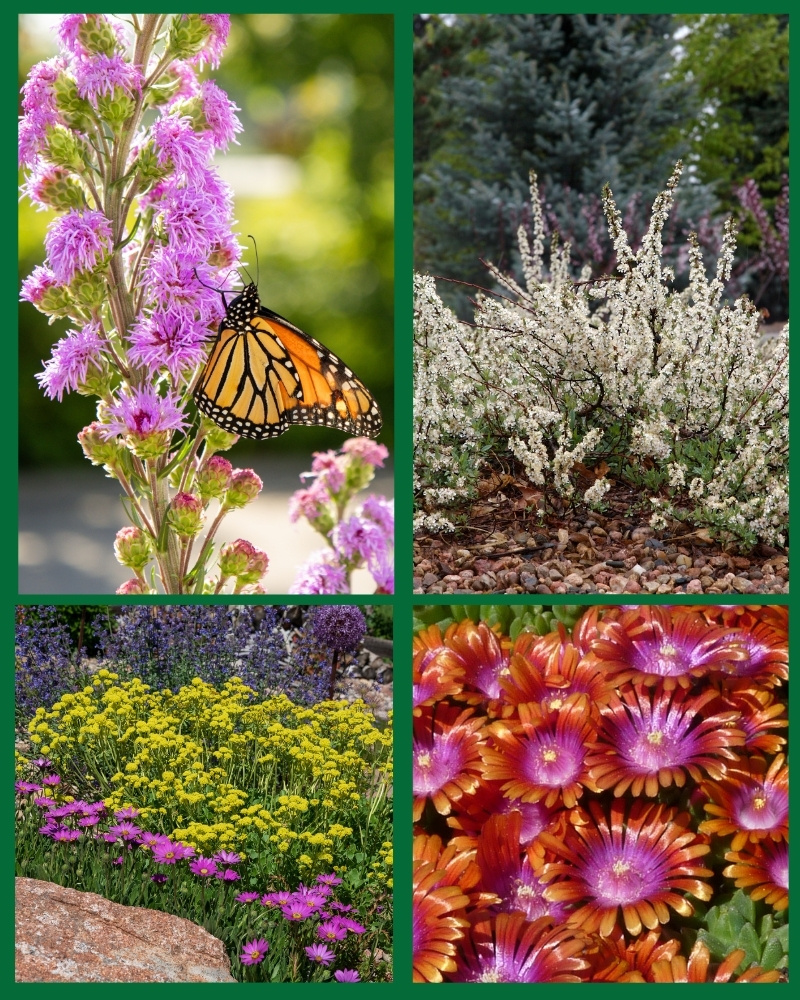Dog Tuff™ Grass – Everything you need to know!

Dog Tuff ™ Grass
This Cynodon selection (Cynodon ‘PWIN04S’) is derived from African grasses similar to American buffalo grass but holds up better to wear and tear. It is a sterile hybrid so it can’t reseed into the wild environment and become an invasive weed (although it could get into your neighbor’s yard via runners!)
 Dog Tuff ™ is:
Dog Tuff ™ is:
• VERY drought tolerant
• VERY resistant to dog urine
• LOVES full, hot sun
• GROWS happily on dry slopes
• DOESN’T wear thin in the winter like buffalo grass
• RECOVERS from excessive foot traffic quickly
• HONEYBEES love the pollen
Dog Tuff ™ is:
• Not tolerant of shade
• Not tolerant of weed killers like 2,4-D or glyphosate
• Not green until early June (in the Colorado Front Range)
• Not green after October 1st (in the Colorado Front Range)
• Not useful in USDA zones colder than zone 5
How do I prepare my lawn area for planting Dog Tuff ™ grass plugs in EXISTING TURF?
Dog Tuff ™ does not blend well with other grasses.
• Kill the lawn at least 2 weeks before planting if you use glyphosate or horticultural vinegar (Colorado State University Extension). If you prefer organic alternatives for killing turf, please refer to this PDF from The Xerces Society. (For the latter, your time frame will vary.)
• Irrigate the ground thoroughly several days ahead of plug planting day (about June 1). The tender young plants will not tolerate drying out or frost.
How do I prepare my lawn area for planting Dog Tuff ™ in bare or NEWLY PREPARED soil?
If you’ve prepared a new site with soil amendment and cultivation:
• Remove any existing weeds or grass.
• Incorporate 1-2 inches of compost into the soil with a tiller (optional).
• Irrigate the ground thoroughly several days ahead of plug planting day (about June 1). The tender young plants will not tolerate drying out or frost.
• OR wait until after planting the plugs a sow ANNUAL RYE grass over the area to act as a nurse crop for the Dog Tuff ™ plugs.
What should I expect when I get my Dog Tuff ™ grass plugs?
• The grass generally comes in plug trays that contain 72-78 plants. Planted one foot apart, this will cover 72-78 square feet.
• Be sure to keep your plugs watered and in an area protected from hot sun until installation. It’s best to “harden them off” for a few days before installation.
• In USDA zone 5, you must wait to install the plugs until the soil is at least 50°F. This is usually (at the earliest) the last week of May. June 1st is a better bet. This grass can be planted any time from late May until July 15th. Late plantings may not fill in until the second summer. Over-seed with annual rye if planted late. his will reduce mud in the first winter.
 Installation of Dog Tuff ™ Grass Plugs
Installation of Dog Tuff ™ Grass Plugs
• Irrigate the ground thoroughly several days ahead of planting the plugs. Soil must be moist when the plugs are installed.
• Apply a light amount of organic fertilizer such as Alpha One (alfalfa meal).
• Punch holes in the ground using a metal crow bar, hori hori knife or 1.5 inch auger drill, 1 inch deep. The auger works better if you are installing several trays of plugs. We recommend planting the plugs one foot apart.
• Gently remove the plugs from the tray by pushing them up from the bottom. Do not PULL them from the top as this may damage the roots.
• Plant in the cooler hours of the day.
• Water in the plugs occasionally as you go so that they don’t dry out. Try marking a nylon string every twelve inches with a marker to use as a guide.
• Water the area lightly 2-3 times a day for a week, about once a day the second week and every other day or so by the third week. The more you water it, the faster it will grow.
Maintenance of Dog Tuff ™ Grass
• Water your new grass less than once a week the second year and beyond. It may only require water every 10-14 days once fully established.
• Apply ½ to 1 inch of water per irrigation so that the water penetrates deeply. This will give the grass its drought resilience.
• Fertilize Dog Tuff ™ grass only in May and mid-September. Use organics such as alfalfa-based fertilizers, kelp-based fertilizers or poultry waste-based fertilizers or Milorganite. If using corn gluten as a fertilizer/pre-emergent herbicide, apply it in late October, late February and early May. Conventional, chemical fertilizers may cause excessive, “hard to manage” growth.

Mowing Dog Tuff™ Grass
• Dog Tuff ™ does not require mowing unless you prefer a low, trim look. It only grows 2 ½-4 inches high when left unmowed.
• If you do wish to mow it, start in early July and mow every 5 to 7 days to maintain a lush, manicured look. If you wait more than 7 days to mow it, remove NO MORE than ½ inch of growth at a time as it will “scalp” and sun burn and look very bad.
• Without mowing, Dog Tuff ™ grows in gentle mounds, which look more like woodland moss.
• Do NOT cut the grass short before winter.
• Trim the dead growth from the lawn in spring before the new growth appears in June. Cut it as short as your mower will allow, maximizing the spring growth and aesthetic. If you’ve used organic fertilizers, this trim makes excellent mulch in the vegetable garden.
• On putting greens and bowling greens, Dog Tuff ™ should be mown daily during active growth.
Weed Control on Dog Tuff™ Grass
• Avoid using weed killers on Dog Tuff ™ Grass if possible.
• Dog Tuff™ grass is very sensitive to the weed-killing herbicides such as 2,4-D, Dicamba, etc., as well as the all-purpose weed killers that contain glyphosate (such as Roundup® and KillzallII). Do not use weed and feed fertilizers as they contain these chemicals also. Colorado State University tested Amine 4 2,4-D at a rate of 4 tsp per gallon on Dog Tuff Grass with good results.
• Spot spraying with these chemicals can be done if you only spray the weed. Horticultural vinegar is much safer for the Dog Tuff™ grass and works great on the weeds.
• Conventional weed killers like 2,4-D and gylphosate can be used when Dog Tuff™ grass is completely dormant in March and November, but their use may be risky.
Weed Prevention
• Corn gluten: If using, apply in late October in Denver area, late February and early May to cover most weed seed germination times. It can be applied through a fertilizer broadcast spreader or is available in a liquid form that is applied through a hose-end sprayer. Corn gluten has not been scientifically proven to be effective in all cases.
• Freehand® pre-emergent herbicide was tested by Colorado State University on the grass and showed no visible phytotoxicity.
Where to Buy
Click here for a listing of growers and retailers that carry Dog Tuff™ grass.
Wholesale: contact us
©2015 Kelly D. Grummons, Horticulturist and Plant Developer. Updated: May 2023


